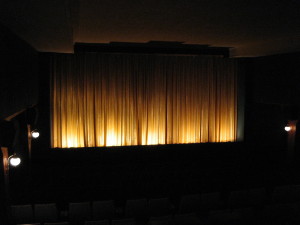A look inside Access Project: making theater open to all
by Beth
This past week I attended two plays I would have never seen experienced otherwise.
Let me explain.
Chicago’s Victory Gardens Theater moved to its new location at Biograph Theater (yes, the landmark building where gangster John Dillinger was ambushed) in 2006. The refurbished building boasts an elevator, ramps, wide hallways, widened doorways. A perfect location for Access Project, a nationally-recognized outreach effort to involve people with disabilities in all aspects of theater. Access Project designates certain performances as “Access Nights” by offering additional accessibility services to Victory Garden patrons. But wait…there’s more! Access Project also teams up with smaller theater companies (some who usually perform in small inaccessible spaces in basements, above taverns, down narrow hallways) from time to time to sponsor a one-night-fits-all production in Victory Gardens’ very accessible space.
Both productions I went to this week were produced by smaller Chicago theater companies hosted by Victory Gardens at the refurbished Biograph Theater:
- Once in a Lifetime, a 1930 play by George S. Kaufman and Moss Hart, was performed by Straw Dog Theatre company at Victory Gardens last night. . Chicago Tribune critic Chris Jones said the play is “seldom revived, and a lot of that has to do with the humongous cast of characters, featuring nearly 40 speaking parts.”
- Too Much Light Makes the Baby Go blind is a production by the Neo-Futurists that attempts to perform 30 skits in 60 minutes. They performed their “ever-changing menu” last Saturday night at Victory Gardens.
Dozens of characters. Actors playing multiple parts. Many, many scene changes. These particular two plays would have been recipes for blind disaster, but the thought put into the touch tours before each production — coupled with speedy Shayne Kennedy providing audio description in my headset for both plays — helped me take it all in.
Okay, maybe not all, but far more than I would have otherwise. Because, honestly, without this sort of special accommodation, I wouldn’t have considered attending these two complicated plays at all.
Audio touch tours are much more than just the tactile experience the name implies — a Touch Tour is a pre-performance program that gives those of us who are blind or have low vision an opportunity to:
- participate in an artistic conversation about a production
- experience a detailed description of the set, props and costumes
- handle key props, set and costume pieces
- tour the set with a sighted guide
- meet the actors, hear the voices they’ll be using on stage, and learn about the characters they play
When the plays were about to start, I was offered an ear piece connected to a small device the size of an old-fashioned cell phone — it had a volume control dial so I could rev it up to hear the audio describer alert me to scene changes, character entrances/exits and other movements during the play. I usually can follow the play just fine and opt to go without the ear piece. Not this time, though. With one show offering 30 skits in 60 minutes, and the other featuring 40 speaking parts, trust me, I cherished those headphones — almost as much as I cherished the opportunity to seetake in these two fine productions.






